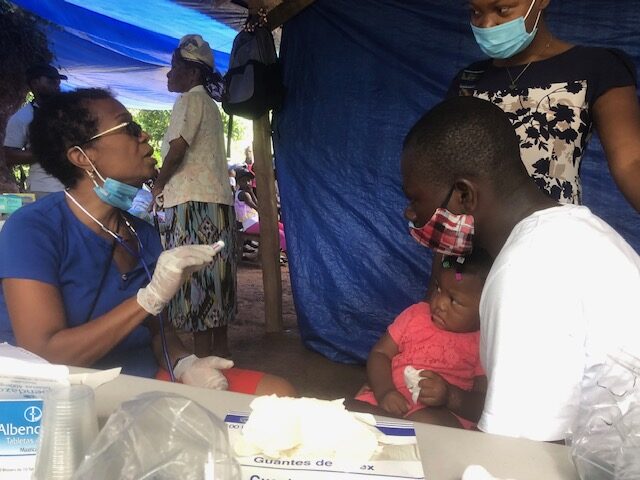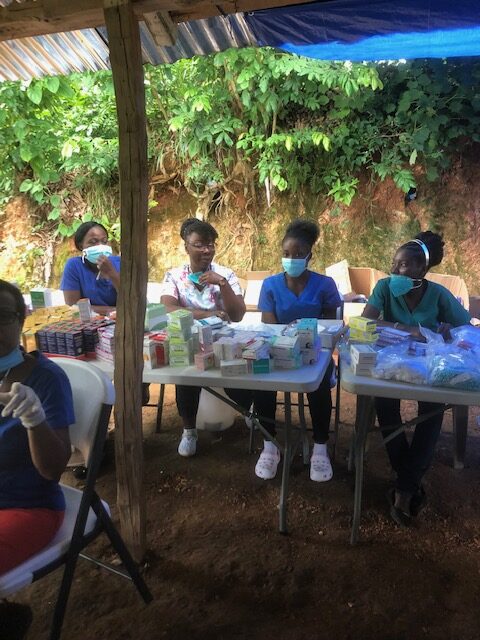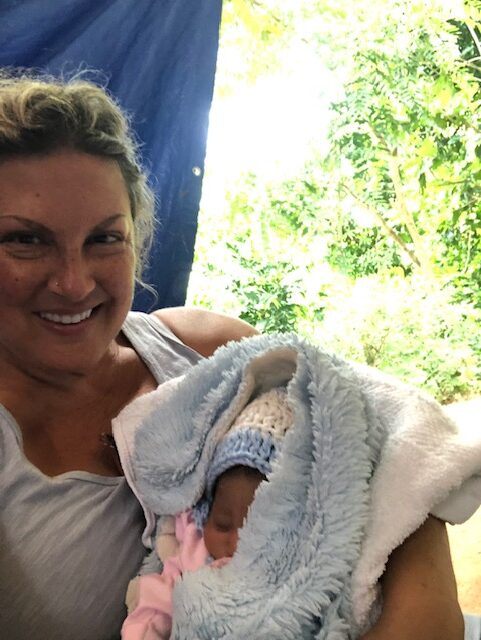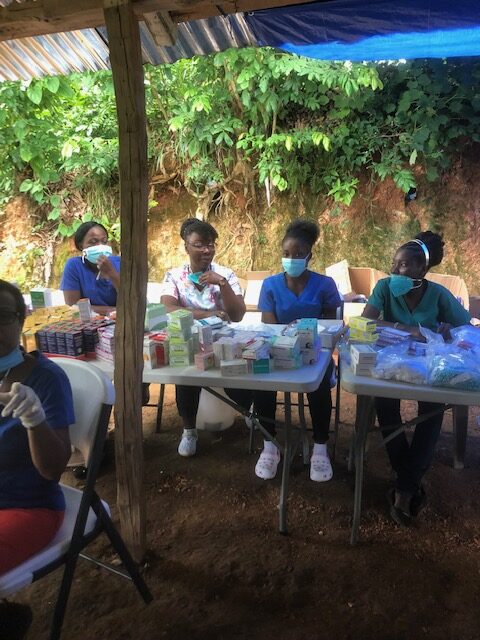10/6/21
On Monday, I made it on the p.m. flight to Les Calles and was greeted by Joel and taken to COFHED’s compound run by Nick and Madeline in Camp-Perin. They have been so gracious! We each have our own bed and only six of us have to share one bathroom! Usually, I sleep with someone and there’s like fifteen people per bathroom! We all ate our Haitian dinner and went off to bed. I was woken by what felt like someone shaking my bed. My first thought was that it was an earthquake, but no one got up. I didn’t sleep well after that and was woken up again by someone shaking my bed even harder. I couldn’t get back to sleep. As I tossed and turned, I was cursing Liane for shaking my bed (for what I guessed was my snoring). But, no! There were two “tremors!”

Our first clinic day we loaded up two trucks with boxes of medications, supplies, tables, tarps, and chairs. We were going to Raymond but ten minutes into our drive, the road was completely washed out by the rains the day before! We stopped at a place where the houses were completely leveled. They were starting to rebuild using wood cut with a machete. Gladys asked if we could make a little clinic on their premises and they graciously responded, “Oui.
The floor was dirt with holes covered with aluminum siding, and the COFHED people got to work making a roof from tarps strapped to the stick “infrastructure.” We have three nurses who were the first to graduate from Gladys’s tech school in Mussotte, which opened in 2016. I tried to speak French with them, but I feel like a three-year-old when I speak! They had organized all the meds during the “rain day,” so we left it to them to woman the “pharmacy.”
As we saw patients, Joel translated for me. Gladys started seeing the kids. We saw that we wouldn’t finish any time soon, so I had Joel start seeing patients on his own. We had picked up student nurses on the way and they helped do vitals. Liane was our lab tech. It goes like this: “What do you have?” and the answer is usually at least three of the following: pain everywhere, itch everywhere, itchy eyes, vaginal infection, dizzy, epigastric pain, and insomnia. “Since when?” Answer: “Long time” or “Since the earthquake.” So meds are: paracetamol (similar to Tylenol), loratadine/hydrocortisone cream/antifungal cream, eye allergy drops, metronidazole, omeprazole (Thank you Sara and Alexandra for counting out a kajillion omeprazole pills!) But I didn’t bring anything for sleep! Usually I do, but I only had three suitcases this time. One woman said she had a headache, a “cold,” abdominal pain, and diarrhea. “Cold” means stuffy nose. I did bring the CVS rapid COVID test and hers was positive!
Soon after we started, Gladys brought a little boy over by the hand. “This one needs to go to the hospital,” she said. He was four years old. His belly was huge, like more huge than what we normally see with Kwashiokor malnutrition. Plus, he didn’t have the other stigmata of Kwashiokor like leg edema or blond hair. In fact, you could see the outline of a huge liver and spleen from ten feet away. He looked like a balloon with little legs and a head. His ribs were sooo taught though, and you could see him breathing fast. The mom had given the kid to the dad, not knowing how to care for him, and the dad had left him with his mother-in-law. Gladys asked the kid about his history. He told her that he had been taken to a hospital and got better but then got worse.
I told Gladys to put him on my lap while I saw patients because I just wanted to give him some love. She refused. “You have 200 patients to see, you can’t have him on your lap.” “Then put him on someone’s lap!” I said. We discussed the fact that he might have hepatitis or a hepatic abscess. I saw a kid like this in the jungle of Ecuador who was diagnosed with hepatitis due to Hep B, I think. Anyway, Gladys gave the grandmother money to take him to the hospital and she knew which hospital to go to in Les Cayes.
Interestingly, not too many people we saw had hypertension (HTN)! Every time I have ever been to Haiti, 2/3 of the adults had HTN. This time we saw maybe five people with HTN? There was one woman with very high blood pressure complaining that she couldn’t see very well. So, we checked her blood sugar and it was high. We did some education regarding diet and the importance of compliance. The rest of the day was “doule estomak,” “gratel (itch),” etc. We finished late and saw around 170 people. We were tired! I went to bed at 9:00 after finishing my book and taking my sleeping pill (and realizing our patients don’t have any—I was grateful that I did). There were no tremors, and I woke up at 7 a.m.!
On day 3 (today), we drove about twenty minutes on a winding dirt road, passing a huge river to Maroterre. We made a clinic at an outdoors church. A tarp was already set up, and patients were waiting on the benches. The student nurses did the vitals and chief complaints, and we had a volunteer doctor join us who was trained in Cuba so we could communicate in Spanish (however, I started mixing French, Spanish and English, and became quite tongue-tied). She saw patients along with me, Joel, and Gladys. I decided to create my own mini-pharmacy for the basics to make things go quicker. We had run out of lancets (we figured they got left behind in Fort Lauderdale during my attempted sprint), so Nick gave us his!

We heard the same complaints today, which can get a bit boring. But, we are giving free meds for common ailments when they have NO sense of a medicine cabinet like we have at home! Nothing for pain or stomachache or fever…NOTHING. A few minutes into the day, Joel brought over a woman, saying, “This will be interesting.” Her blood pressure was 230 something over 160 something! She was 38. She couldn’t talk but she understood and would nod “yes” or “no.” Her mother was with her. Basically, she woke up yesterday not being able to talk or walk. At first, I thought Joel said she was like this since March. She had a left facial droop and was slightly weaker on her right side. Classic left-sided stroke, which affects one’s speech. We tried to give her Amlodipine 5 mg right there, but she couldn’t swallow.
“How is she not dead if she can’t swallow?” I wondered. Joel then clarified that all of this started yesterday. “Oh, she needs to go to the hospital,” both Gladys and I chime in together. Now usually, sending someone to the hospital isn’t always the better choice, but Gladys was confident that this particular hospital could give her IV blood pressure meds and IV fluids. But in Haiti, you have to purchase everything from the pharmacy and bring it back to the hospital. Gladys gave her some Haitian money and I said I would pay her back.
We as “first world” citizens don’t understand what it’s like to live in a country with no government infrastructure and safety nets. If we are sick, we call 911, are taken to an ER, where they are required to give lifesaving treatment (called EMTALA law in the US which began in the early 90’s in response to the AIDS epidemic when ERs were refusing to care for AIDS patients). Our medical system is far from perfect, but more so now with the expanded Medicaid program (in most states…the South—get with the program!), we’ve got it pretty good compared to Haiti! Can you imagine having to purchase the IV fluids and IV antibiotics before the Doctors and Nurses can attend to you during an emergency! Can you imagine no 911 system? No police? No fire stations?

We saw 207 patients today. We leave for Mussotte tomorrow (where it’s nice and cool up in the mountains), so basically we’ll have a day off! The road from Les Cayes to Mussotte is safe, unlike the road to from PAP to Mussotte. It’s nice not to worry about the gangs in the rural areas!
Funny anecdote: yesterday when we got to the spot, my intestines decided they wanted to release their goods. So, Gladys gave me a roll of toilet paper, and Joel found a guy to take me to the “twalet.” He grabbed my hand and we literally hiked down the muddy hill through the thick brush until we get to a cement block where he helped me up. There was a cement, round funnel about two feet tall. You couldn’t see inside, but I could imagine. I sat on my throne with a view of the entire valley of thick, luscious, green brush. I couldn’t have been happier! Today, once again, around the same time I may add, my intestines were doing the same dance. Again, a local guy took my hand, we walked down the rocky road, and he took me behind someone’s “house” where coffee beans had just been picked and presented to me another cement block but this time with a toilet on top of a hole. We were joking that I’ve been researching the sanitation systems of the South of Haiti, which seem to be functioning well!

